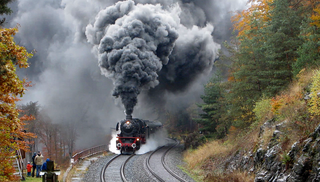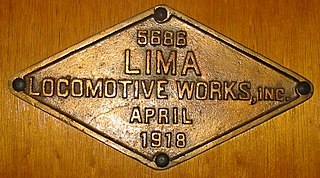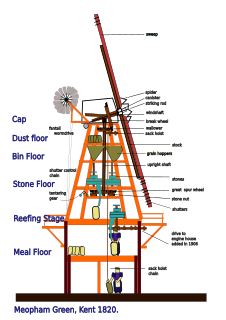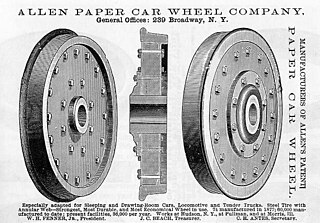Life
He became a blacksmith like his father. In 1812, he moved to New Hampshire. After a short time, his employer sent him to Brownsville, New York, to supervise the installation of machinery at a cotton factory, and Whitney remained in New York. About 1830, he was hired by the Mohawk and Hudson Railroad to make machinery and railway carriages, and after a few years became superintendent of the line.

A blacksmith is a metalsmith who creates objects from wrought iron or steel by forging the metal, using tools to hammer, bend, and cut. Blacksmiths produce objects such as gates, grilles, railings, light fixtures, furniture, sculpture, tools, agricultural implements, decorative and religious items, cooking utensils and weapons.

New Hampshire is a state in the New England region of the northeastern United States. It is bordered by Massachusetts to the south, Vermont to the west, Maine and the Atlantic Ocean to the east, and the Canadian province of Quebec to the north. New Hampshire is the 5th smallest by area and the 10th least populous of the 50 states. Concord is the state capital, while Manchester is the largest city in the state. It has no general sales tax, nor is personal income taxed at either the state or local level. The New Hampshire primary is the first primary in the U.S. presidential election cycle. Its license plates carry the state motto, "Live Free or Die". The state's nickname, "The Granite State", refers to its extensive granite formations and quarries.

New York is a state in the Northeastern United States. New York was one of the original thirteen colonies that formed the United States. With an estimated 19.54 million residents in 2018, it is the fourth most populous state. To distinguish the state from the city with the same name, it is sometimes called New York State.
In February 1840, he was elected by the New York State Legislature as one of the Erie Canal commissioners, and remained in office until 1842 when the Democratic majority removed the Whig commissioners.

The New York State Legislature consists of the two houses that act as the state legislature of the U.S. state of New York. The New York Constitution does not designate an official term for the two houses together. It says only that "legislative power is vested in the senate and assembly." The session laws are published in the official Laws of New York. The permanent laws of a general nature are codified in the Consolidated Laws of New York. The legislature is seated at the New York State Capitol in Albany.
The Commission to Explore a Route for a Canal to Lake Erie and Report, known as the Erie Canal Commission, was a body created by the New York State Legislature in 1810 to plan the Erie Canal. In 1817 a Canal Fund led by Commissioners of the Canal Fund was established to oversee the funding of construction of the canal. In 1826 a Canal Board, of which both the planning commissioners and the Canal Fund commissioners were members, was created to take control of the operational canal. The term "Canal Commission" was at times applied to any of these bodies. Afterwards the canal commissioners were minor state cabinet officers responsible for the maintenance and improvements of the state's canals.
In 1842, he formed a partnership with Matthias W. Baldwin to manufacture steam locomotives in Philadelphia. Two years later he left Baldwin, and worked for the reorganized Morris Canal Company. In 1846, he opened his own factory to manufacture wheels for railway carriages. In 1847, he took out patents for the corrugated-plate carriage wheel and the curved corrugated-plate carriage wheel, and the following year for the process of annealing carriage wheels. This consisted of placing the wheels, soon after they were cast, in a heated furnace, where they were subjected to a further gradual increase of temperature, and were then slowly cooled for three days. The discovery of this process of annealing, as applied to chilled cast-iron wheels, marked an era in the history of railroads. It enabled trains to safely increase both loads and speed. Previous to this discovery it was impossible to cast wheels with solid hubs, and therefore impossible to secure them rigidly to the axle. Now the whole wheel was easily cast in one piece, and capable of being forced securely upon the axle at a pressure of 40 tons. In 1850, he patented the tapered and ribbed corrugated wheel.

Matthias William Baldwin was an American inventor and machinery manufacturer, specializing in the production of steam locomotives. Baldwin's small machine shop, established in 1825, grew to become Baldwin Locomotive Works, one of the largest and most successful locomotive manufacturing firms in the United States. The most famous of the early locomotives was Old Ironsides, built by Matthias Baldwin in 1832.

A steam locomotive is a type of railway locomotive that produces its pulling power through a steam engine. These locomotives are fueled by burning combustible material – usually coal, wood, or oil – to produce steam in a boiler. The steam moves reciprocating pistons which are mechanically connected to the locomotive's main wheels (drivers). Both fuel and water supplies are carried with the locomotive, either on the locomotive itself or in wagons (tenders) pulled behind.

The Morris Canal (1829–1924) was a 107-mile (172-km) common carrier coal canal across northern New Jersey in the United States that connected the two industrial canals at Easton, Pennsylvania, across the Delaware River from its western terminus at Phillipsburg, New Jersey, to New York Harbor and the New York City markets via its eastern terminals in Newark and on the Hudson River in Jersey City, New Jersey.
Whitney was for a short time president of the Philadelphia and Reading Railroad, but retired in 1861 because of ill health. He gave $50,000 to found a professorship of dynamical engineering in the University of Pennsylvania, $12,500 to the Franklin Institute, and $20,000 to the old men's home in Philadelphia.

The University of Pennsylvania is a private Ivy League research university located in the University City neighborhood of Philadelphia, Pennsylvania. It is one of the nine colonial colleges founded prior to the Declaration of Independence and the first institution of higher learning in the United States to refer to itself as a university. Benjamin Franklin, Penn's founder and first president, advocated an educational program that trained leaders in commerce, government, and public service, similar to a modern liberal arts curriculum. The university's coat of arms features a dolphin on its red chief, adopted from Benjamin Franklin's own coat of arms.

The Franklin Institute is a science museum and the center of science education and research in Philadelphia, Pennsylvania. It is named after the American scientist and statesman, Benjamin Franklin, and houses the Benjamin Franklin National Memorial. Founded in 1824, the Franklin Institute is one of the oldest centers of science education and development in the United States.
He died in Philadelphia and is interred at The Woodlands Cemetery. [1]
After Whitney's death, the factory, which had been once the largest carriage-wheel manufacturer in the United States, was taken over by his three sons: George Whitney (d. 1885), John R. Whitney and James S. Whitney. In 1891, the company was in financial trouble and going bankrupt.

A bogie is a chassis or framework that carries a wheelset, attached to a vehicle—a modular subassembly of wheels and axles. Bogies take various forms in various modes of transport. A bogie may remain normally attached or be quickly detachable ; it may contain a suspension within it, or be solid and in turn be suspended ; it may be mounted on a swivel, as traditionally on a railway carriage or locomotive, additionally jointed and sprung, or held in place by other means.

Continuous track, also called tank tread or caterpillar track, is a system of vehicle propulsion in which a continuous band of treads or track plates is driven by two or more wheels. This band is typically made of modular steel plates in the case of military vehicles and heavy equipment, or synthetic rubber reinforced with steel wires in the case of lighter agricultural or construction vehicles.

Aaron Lufkin Dennison was an American watchmaker and businessman who founded a number of companies.

A velocipede is a human-powered land vehicle with one or more wheels. The most common type of velocipede today is the bicycle.

Lima Locomotive Works was an American firm that manufactured railroad locomotives from the 1870s through the 1950s. The company took the most distinctive part of its name from its main shop's location in Lima, Ohio. The shops were located between the Baltimore & Ohio's Cincinnati-Toledo main line and the Nickel Plate Road main line and shops.

Under the Whyte notation for the classification of steam locomotives, 4-2-0 represents the wheel arrangement of four leading wheels on two axles, two powered driving wheels on one axle and no trailing wheels. This type of locomotive is often called a Jervis type, the name of the original designer.

Under the Whyte notation for the classification of steam locomotives by wheel arrangement, 4-6-0 represents the configuration of four leading wheels on two axles in a leading bogie, six powered and coupled driving wheels on three axles and no trailing wheels. In the mid 19th century, this wheel arrangement became the second most popular configuration for new steam locomotives in the United States of America, where this type is commonly referred to as a Ten-wheeler.As a locomotive pulling trains of lightweight all wood passenger cars in the 1890-1920s, it was exceptionally stable at near 100 mph speeds on the New York Central's New York to Chicago Water Level Route and on the Reading Railroad's Camden to Atlantic City, NJ, line. As passenger equipment grew heavier with all steel construction, heavier locomotives replaced the Ten Wheeler.

The Norris Locomotive Works was a steam locomotive manufacturing company based in Philadelphia, Pennsylvania, that produced nearly one thousand railroad engines between 1832 and 1866. It was the dominant American locomotive producer during most of that period, as well as the first major exporter of American locomotives, selling its popular 4-2-0 engines to railways in Europe and building the first locomotive used in South America.

A jackshaft is an intermediate shaft used to transfer power from a powered shaft such as the output shaft of an engine or motor to driven shafts such as the drive axles of a locomotive. As applied railroad locomotives in the 19th and 20th centuries, jackshafts were typically in line with the drive axles of locomotives and connected to them by side rods. In general, each drive axle on a locomotive is free to move about one inch (2.5 cm) vertically relative to the frame, with the locomotive weight carried on springs. This means that if the engine, motor or transmission is rigidly attached to the locomotive frame, it cannot be rigidly connected to the axle. This problem can be solved by mounting the jackshaft on unsprung bearings and using side-rods or chain drives.

Ross Winans (1796–1877) was an American inventor, mechanic, and builder of locomotives and railroad machinery. He is also noted for design of pioneering cigar-hulled ships. Winans, one of the United States' first multi-millionaires, was involved in national and state politics, a southern-sympathizer and was a vehement "states' rights" advocate. His outspoken anti-federal stance as a member of the Maryland House of Delegates, the lower chamber of the General Assembly, led to his temporary arrest on board a Baltimore and Ohio Railroad train returning from an early session of the legislature held in the western Maryland town of Frederick to avoid the Union Army-occupied state capital of Annapolis in April–May, 1861, to consider the possibilities of state secession, during the early decisive period of the American Civil War. Winans was related to James McNeill Whistler through marriage.

The artillery wheel was developed for use on gun carriages when it was found that the lateral forces involved in horse artillery manoeuvres caused normally constructed cart wheels to collapse. Rather than having its spokes mortised into a wooden nave (hub), it has them fitted together (mitred) then bolted into a metal nave. Its tyre is shrunk onto the rim in the usual way but it is also bolted on for security. A normal wagon wheel is dished so that in its lowest part, the spokes are perpendicular to the ground thus supporting the weight. This is not done with artillery wheels.

This glossary of mill machinery covers the major pieces of machinery to be found in windmills, watermills and horse mills. It does not cover machinery found in modern factories.

A jackshaft, also called a countershaft, is a common mechanical design component used to transfer or synchronize rotational force in a machine. A jackshaft is often just a short stub with supporting bearings on the ends and two pulleys, gears, or cranks attached to it. In general, a jackshaft is any shaft that is used as an intermediary transmitting power from a driving shaft to a driven shaft.

Henry Burden was an engineer and businessman who built an industrial complex in Troy, New York called the Burden Iron Works. Burden's horseshoe machine, invented in 1835, was capable of making 60 horseshoes a minute. His rotary concentric squeezer, a machine for working wrought iron, was adopted by iron industries worldwide. His hook-headed spike machine helped fuel the rapid expansion of railroads in the U.S. The Burden Iron Works is now an historical site and museum.
H. A. Moyer Automobile Company (1908–1915), a manufacturer of luxury automobiles in Syracuse, New York, was founded by Harvey A. Moyer (1853–1935) of Clay, New York. The company began business in 1876 in Cicero, New York, as H. A. Moyer Carriage Company. As the era of the horse-drawn carriage came to an end, Moyer switched assembly to motor vehicles, although he still produced carriages for some time after that.
Isaac Dripps was an American machinist and inventor. He worked on the locomotive John Bull and built seven locomotives. Dripps was a superintendent and partner of various railroad machinery shops. He has several patents to his name.
Henry Roe Campbell was a prominent American surveyor and civil engineer. Campbell made significant contributions to American railroading and bridge building in the first half of the 19th century being known as the known as "The Bridge builder of New England" as well as the inventor of the 4-4-0 steam locomotive. Campbell patented his 4-4-0 design in February 1836, just a few months before the patent law was changed to require that claims include proof of originality or novelty.
The 4-4-0 or American type steam locomotive was the most popular wheel arrangement in 19th century American railroads and was widely copied. White noted that the design was successful because it .."met every requirement of early United States railroads".
At the end of Campbell's career. a Harper's Magazine article in March,1879 noted that the impact Campbell's design played in railroad development in the United States when it wrote...

Paper car wheels were composite wheels of railway carriages, made from a wrought iron or steel rim bolted to an iron hub with an interlayer of laminated paper. The center was made of compressed paper held between two plate-iron disks. Their ability to damp rail/wheel noise resulted in a quiet and smooth ride for the passengers of North American Pullman dining and sleeping cars.


























